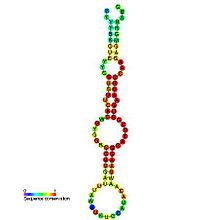mir-124 microRNA precursor family
This article's use of external links may not follow Wikipedia's policies or guidelines. (October 2020) |
| miR-124 microRNA precursor family | |
|---|---|
 Predicted secondary structure and sequence conservation of mir-124 | |
| Identifiers | |
| Symbol | mir-124 |
| Rfam | RF00239 |
| miRBase | MI0000443 |
| miRBase family | MIPF0000021 |
| Other data | |
| RNA type | Gene; miRNA |
| Domain(s) | Eukaryota |
| GO | GO:0035195 GO:0035068 |
| SO | SO:0001244 |
| PDB structures | PDBe |
The miR-124 microRNA precursor is a small non-coding RNA molecule that has been identified in flies (MI0000373),[1] nematode worms (MI0000302),[2] mouse (MI0000150) and human (MI0000443).[3] The mature ~21 nucleotide microRNAs are processed from hairpin precursor sequences by the Dicer enzyme, and in this case originates from the 3' arm. miR-124 has been found to be the most abundant microRNA expressed in neuronal cells. Experiments to alter expression of miR-124 in neural cells did not appear to affect differentiation.[4] However these results are controversial since other reports have described a role for miR-124 during neuronal differentiation.[5][6]
Targets of miR-124
[edit]- Visvanathan et al. showed that miR-124 targets the mRNA of the anti-neural function protein SCP1 (small C-terminal domain phosphatase 1).[7]
- Makeyev et al. showed that miR-124 directly targets PTBP1 (PTB/hnRNP I) mRNA, which encodes a global repressor of alternative pre-mRNA splicing in non-neuronal cells.[8]
- Arrant et al. wrote that miR-124 changes glutamate receptor composition in the prefrontal cortex and can decrease social dysfunction in frontotemporal dementia.[9]
Clinical medicine
[edit]Presence of the G allele, compared to the C allele, in SNP rs531564 in pri-miR-124-1, measured by PCR-RFLP in leukocyte DNA, is linked to a reduced risk of gastric cancer (e.g. GG v CC OR 0.34 95% CI 0.19-0.59, p<0.001).[10]
References
[edit]- ^ Lai EC, Tomancak P, Williams RW, Rubin GM (2003). "Computational identification of Drosophila microRNA genes". Genome Biology. 4 (7): R42. doi:10.1186/gb-2003-4-7-r42. PMC 193629. PMID 12844358.
- ^ Lim LP, Lau NC, Weinstein EG, Abdelhakim A, Yekta S, Rhoades MW, et al. (April 2003). "The microRNAs of Caenorhabditis elegans". Genes & Development. 17 (8): 991–1008. doi:10.1101/gad.1074403. PMC 196042. PMID 12672692.
- ^ Lagos-Quintana M, Rauhut R, Yalcin A, Meyer J, Lendeckel W, Tuschl T (April 2002). "Identification of tissue-specific microRNAs from mouse". Current Biology. 12 (9): 735–739. doi:10.1016/S0960-9822(02)00809-6. hdl:11858/00-001M-0000-0010-94EF-7. PMID 12007417. S2CID 7901788.
- ^ Cao X, Pfaff SL, Gage FH (March 2007). "A functional study of miR-124 in the developing neural tube". Genes & Development. 21 (5): 531–536. doi:10.1101/gad.1519207. PMC 1820895. PMID 17344415.
- ^ Yoo AS, Staahl BT, Chen L, Crabtree GR (July 2009). "MicroRNA-mediated switching of chromatin-remodelling complexes in neural development". Nature. 460 (7255): 642–646. Bibcode:2009Natur.460..642Y. doi:10.1038/nature08139. PMC 2921580. PMID 19561591.
- ^ Neo WH, Yap K, Lee SH, Looi LS, Khandelia P, Neo SX, et al. (July 2014). "MicroRNA miR-124 controls the choice between neuronal and astrocyte differentiation by fine-tuning Ezh2 expression". The Journal of Biological Chemistry. 289 (30): 20788–20801. doi:10.1074/jbc.m113.525493. PMC 4110287. PMID 24878960.
- ^ Visvanathan J, Lee S, Lee B, Lee JW, Lee SK (April 2007). "The microRNA miR-124 antagonizes the anti-neural REST/SCP1 pathway during embryonic CNS development". Genes & Development. 21 (7): 744–749. doi:10.1101/gad.1519107. PMC 1838526. PMID 17403776.
- ^ Makeyev EV, Zhang J, Carrasco MA, Maniatis T (August 2007). "The MicroRNA miR-124 promotes neuronal differentiation by triggering brain-specific alternative pre-mRNA splicing". Molecular Cell. 27 (3): 435–448. doi:10.1016/j.molcel.2007.07.015. PMC 3139456. PMID 17679093.
- ^ Arrant AE, Roberson ED (December 2014). "MicroRNA-124 modulates social behavior in frontotemporal dementia". Nature Medicine. 20 (12): 1381–1383. doi:10.1038/nm.3768. PMID 25473917. S2CID 1028320.
- ^ Mirnoori SM, Shahangian SS, Salehi Z, Mashayekhi F, Talesh Sasani S, Saedi HS (October 2018). "Influence of single nucleotide polymorphisms in pri-miR-124-1 and STAT3 genes on gastric cancer susceptibility". British Journal of Biomedical Science. 75 (4): 182–186. doi:10.1080/09674845.2018.1492206. PMID 29938592. S2CID 49410250.
External links
[edit]
